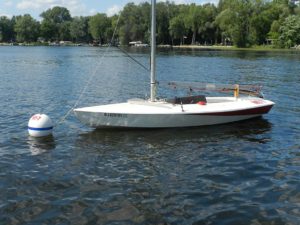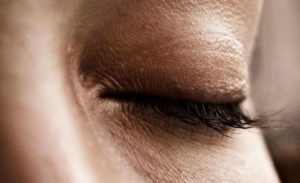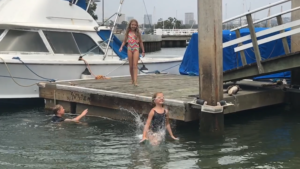 Lesson #1: Paddle boarding visually impaired is the perfect illustration to describe the continuum of blindness that confuses the public (i.e. for people who are perplexed when they see someone with a guide dog or cane reading a text message with their eyes).
Lesson #1: Paddle boarding visually impaired is the perfect illustration to describe the continuum of blindness that confuses the public (i.e. for people who are perplexed when they see someone with a guide dog or cane reading a text message with their eyes).
Navigating around Newport Harbor today reminded me of my favorite quote about my eye disease, Retinitis Pigments. ”RP is seeing a tiny piece of paper across the room and then tripping over an elephant on the way to pick it up.” I paddled hard to the right in order to avoid a small buoy, feeling extremely proud of myself for spotting the bobbing mound of plastic, only to ram the tip of my board directly into a giant boat, which seemed to literally appear out of nowhere, though it rocked there gently all along. That’s RP, my friends: the person standing silently by the elevator, unbeknownst to you, who suddenly says “hi”, startling you to a halt. The trickery of RP is that you see many things. And then you don’t. You think you’re gliding along just fine. And then you crash. You see just enough for your mind to convince you that you’re seeing the whole picture. But you’re not.
The mobility help of a guide dog or cane might seem confusing or unnecessary to some. But it isn’t. Mobility aides keep second-guessing to a minimum and prevent run-ins with mute elephants and strangers near elevators who come out of nowhere (and perhaps with silent sea vessels if they were useful in water). #blindpaddleboarding #guidedogsfortheblind
 Lesson #2 Sometimes you need a little sighted guide.
Lesson #2 Sometimes you need a little sighted guide.
I have my very own petite sighted guide, and her name is Lucy. Since she’s my daughter and should be running around carefree like most 11-year-olds, I try not to ask her to do too many things for me, especially since I want to show her and others how people with sight loss can do almost anything; we just may do it differently.. But as independent as I am, there are times when I need a little help. Like when paddle boarding.
Since moving to SoCal, I’ve paddle boarded several times, so I didn’t really need help figuring it out, but this time the harbor we were launching from was a bit narrow and crowded with docked boats at certain places. And since the rental place was short one board, Lucy and I ended up on the same board. She paddled for the first 20 minutes or so, while I rested on the front of the board, but she got tired of paddling, and since I thought we were past most of the boat congestions, we traded places.
As she sat on the front of our board, shouting “left, left, left!”, I thought she meant “turn left”. For anyone who has paddle boarded (or canoed or kayaked for that matter), you know that paddling on your left actually makes your board or boat goes right, and vice versa. We started to veer right and she began shouting “No! TURN left!” We giggled quite a bit trying to figure out our communication system, but we got it down to a system after a few mishaps! I must say, she was more of a coach than a sighted guide, “3 strokes on your left. 4 on the right. Now put everything into it this time!” “2 left, 2 right. Make this a good one, mom!” She was a very clear, articulate leader, and I could tell it made her feel confident and helpful directing me so effectively. And I didn’t crash once while under her leadership! (which wasn’t the case later in the excursion, after she got off my board!)
The experience of being guided by Lucy reminded me of the gift we can give people when we allow them to help us. I think many of us, sighted or not, “feel bad” asking for assistance, as if we’re “putting them out”, like we’re taking without giving anything in return. We forget that we’re often giving someone a gift- whether it’s allowing them to hone their communication skills or allowing them to feel useful or even good about themselves when they’re having a down day, it can affect them in a positive way too. When we are set on being independent, often because of pride, we are not only depriving ourselves of the help we need, but we are also depriving someone from the opportunity to be a giver.
 Lesson #3 There are many ways to move through life.
Lesson #3 There are many ways to move through life.
I move through much of my life the way my Grandpa Bob did: in my head. I think, and I re-think, and then I think again. When making a decision or choosing which direction to take, I usually make calculated decisions based on logical reasoning. In Western culture, we place a lot of importance on the mind, and we tend to view other ways of coming to conclusions, such as sensing with our hearts, as less than.
Having limited eyesight, I have learned to rely on different senses and different aspects of myself that a fully sighted person may not need to tap into. So while it may feel counterintuitive or frightening to close your eyes while paddle boarding, I found it very relaxing at times. It felt so calming to close my eyes and sense my way through the water at certain points. There was one stretch in particular that I felt I could navigate better with my eyes closed than opened. My family paddled ahead and had no idea I was closing my eyes (it honestly might have freaked them out) I know it sounds strange, since I do have some useable vision, but I think we all possess the capability to feel our way through life more than we realize.
We don’t always find our way by looking with our eyes or thinking with our minds.
Sometimes our intuition helps us sense our way through the course. We can cease the repetitive paddling of our minds, even for a few seconds, and just let the vessel carry us.
Photo by Agustín Ruiz; licensed via Creative Commons.
Lesson #4 There is a time to coast and a time to paddle.
Since moving to SoCal last year, I’ve been working on creating new rhythms to replace the ones I naturally got through the rhythms of the seasons in Illinois. I was reminded of this while paddle boarding. There were certain points where we all just lounged on our boards, enjoying our surroundings. And there were other times that required us to paddle hard to avoid colliding into docked boats or buoys, particularly when it was windy or when a speed boat zoomed past. If we had coasted the entire time, we would not have gotten past the docked boats or seen much of the bay. But if we had hustled the entire time, we would not have really enjoyed the scenery or simply being with one another.
Lesson #5 Learn from the past about when it’s time to drop to your knees.
The second time I went paddle boarding I thought I knew everything I needed to know, so I paddled confidently to the end of the Dana Point harbor, the wind in my favor, gently propelling me forward, alongside my husband and kids, who had rented a tandem kayak Since we rented them for 2 hours, and it took about an hour to paddle to the end of the harbor, I figured leaving ourselves an hour to paddle back would be perfect. I didn’t, however, account for the fact that the wind would be against us. My husband struggled on the kayak a bit but was still able to move forward slowly, so I told him to go ahead and get the kayak turned in, figuring we would only get a late fee for one of our rentals (I am so my dad’s daughter when it comes to late fees and frugality) I, on the other hand, was not moving forward one bit. It was as if I were simply on a paddle board machine at the local gym, paddling in place for exercise. And any small moves I did make seemed to be lateral, as the wind swept me far to the right and then far to the left. A couple kayakers paddled by, yelling “drop to your knees!” but I didn’t really see the point in that, so I just kept standing, and struggling ceaselessly. Finally, one of the employees from the rental company paddled out to “rescue” me. He immediately told me I needed to drop to my knees, saying it would give me more control and prevent my body from being a human sail in the wind. As soon as I did this, I began making progress, and he was able to guide me the rest of the way.
Fortunately, that was the only time I experienced such strong winds. There were, however, some occasional bouts of strong winds during my most recent excursion. And this time, thankfully, I knew when to drop to my knees, so I was able to paddle through the winds.
Spiritually, the idea of dropping to our knees in life, is a bit cliche, but for a reason. The concept of knowing when to ask for help, when to seek power greater than ourselves, when to be humble, and when to drop to our knees is essential to forward movement. I’ve learned this both on and off the paddle board.
Lesson #6 Attempting to Avoid Pain Often Causes More Pain
Like I mentioned in lesson #1, paddle boarding with RP means that I sometimes paddle really hard to avoid a small buoy….only to ram into a large boat. After the first run-in with a large boat, I shifted my thinking to intently looking for large boats, but then I started running into the small buoys. Because there are so many “blind spots” literally, when you’re focusing your attention on one object that you don’t want to run into, you inevitably run into a different object because you’re so intent on avoiding the “potential crash”. After doing this several times, I finally came to this conclusion: there’s no way to avoid every single collision when you’re paddle boarding with RP. Some collisions are inevitable, so why am I spending SO much energy attempting to steer around them? I might as well spend my energy enjoying my time, without angst, and stand firmly rooted on my board so as not to fall when the small collisions occur.
It made me think of times I’ve tried to avoid certain painful situations in my life, only to be confronted with a different problem, often more painful and sometimes as a result of the avoidance. For many years I attempted to hide my vision loss, for example, in order to avoid judgment from others. But since I ran into objects and tripped over curbs, I often incurred more judgment because onlookers had no idea I couldn’t see. Without the knowledge of this key fact, they were left to draw other conclusions about me: She’s clumsy. She’s rude. She’s intoxicated.
Another more general example that comes to mind is someone who avoids the pain of rejection and loss by choosing to avoid intimate relationships, only to end up with a different problem: the pain of loneliness. Or someone who attempts to avoid failing but ends up feeling like a failure for never trying.
Paddle boarding reminds me that we cannot avoid all collisions in life, but we suffer far less when we’re not struggling tirelessly to avoid them.
Lesson #7 Feel nervous? Cling. Adapt. Float. Jump. Transcend. Jump again.
My 7-year-old daughter, Elliana, is the perfect example of someone who overcomes her fears. A lot. She is naturally a bit cautious, especially when it comes to a new physical activity. Yet she always tries it. And she always ends up loving it (minus Splash Mountain- yikes!). I’ve watched her conquer her fear of swimming. Of biking. Of boating. And, most recently, of paddle boarding.
As my husband paddled, Elli sat on the front of the board, gripping the sides tightly. When a speed boat sped past, causing waves, Elli clung to the board terrified. At first. But when she realized her balance was strong enough to steady her, she began to relax and allowed herself to rest casually on the board, and after an hour, she began to have fun with the bobbing motion, shouting “more! more!” by the end of the 2nd hour. Soon, she was chattering about traveling the world on a paddle board. I watched my little girl go from clamoring with fear as she climbed on the board to pantomiming what full time life on a paddle board would look like. When we got back to shore, she jumped off the board to swim the rest of the way to shore. And, in case that wasn’t quite enough thrill, she decided to jump off a nearby docked boat. Talk about progress on a 2-hr paddle board excursion!
Most of us think that we quit doing hard things at the point where it gets really hard, like when we’ve been trying to accomplish something for years and feel like we’re not making progress. But when I really think about the times I’m most tempted to halt, it’s way before the hard work. It’s before the struggling. It’s usually right when I begin to feel nervous. I take it as a sign to stop. Watching my 7-year-old reminds me that feeling nervous to conquer a fear is often the exact time to begin.



awesome stuff. love the 7 points
Joy, wow! Thanks for your wisdom? I certainly relate to all your examples.
Hugs. Kevin Kuhn
Very insightful Joy!!!! You hit so many important points! It really made me feel like I need to venture out in the world more.
You are amazing!! This resonates with so many!